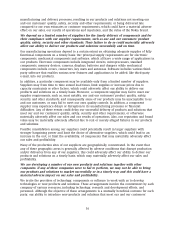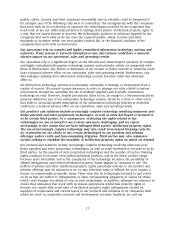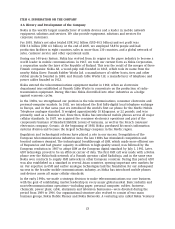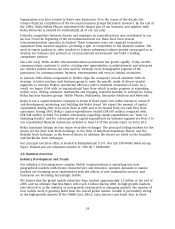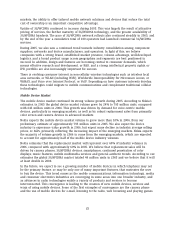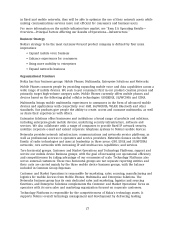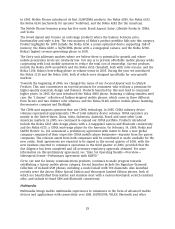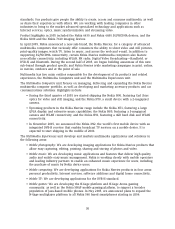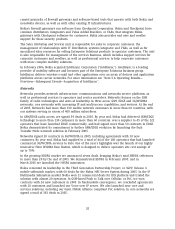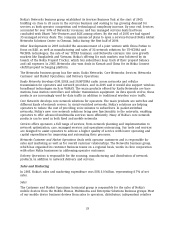Nokia 2005 Annual Report Download - page 25
Download and view the complete annual report
Please find page 25 of the 2005 Nokia annual report below. You can navigate through the pages in the report by either clicking on the pages listed below, or by using the keyword search tool below to find specific information within the annual report.ITEM 4. INFORMATION ON THE COMPANY
4.A History and Development of the Company
Nokia is the world’s largest manufacturer of mobile devices and a leader in mobile network
equipment, solutions and services. We also provide equipment, solutions and services for
corporate customers.
For 2005, Nokia’s net sales totaled EUR 34.2 billion (USD 40.5 billion) and net profit was
EUR 3.6 billion (USD 4.3 billion). At the end of 2005, we employed 58,874 people and had
production facilities in eight countries, sales in more than 130 countries, and a global network of
sales, customer service and other operational units.
During our 140-year history, Nokia has evolved from its origins in the paper industry to become a
world leader in mobile communications. In 1967, we took our current form as Nokia Corporation,
a corporation under the laws of the Republic of Finland. This was the result of the merger of three
Finnish companies: Nokia AB, a wood-pulp mill founded in 1865, which took its name from the
nearby Nokia River; Finnish Rubber Works Ltd, a manufacturer of rubber boots, tires and other
rubber products founded in 1898; and Finnish Cable Works Ltd, a manufacturer of telephone and
power cables founded in 1912.
Nokia entered the telecommunications equipment market in 1960, when an electronics
department was established at Finnish Cable Works to concentrate on the production of radio-
transmission equipment. During this time Nokia diversified into other industries as a hedge
against economic cycles.
In the 1980s, we strengthened our position in the telecommunications, consumer electronics and
personal-computer markets. In 1982, we introduced the first fully-digital local telephone exchange
in Europe, and in that same year we introduced the world’s first car phone for the Nordic Mobile
Telephone analogue standard. It weighed approximately 10 kilograms, or 22 pounds, and was
primarily used as a business tool. Since then, Nokia has introduced mobile phones across all major
cellular standards. In 1987, we acquired the consumer electronics operations and part of the
components business of Standard Elektrik Lorenz of Germany, as well as the French consumer
electronics company, Oceanic. At the beginning of 1988, Nokia purchased Ericsson’s information
systems division and became the largest technology company in the Nordic region.
Regulatory and technological reforms have played a role in our success. Deregulation of the
European telecommunications industries since the late 1980s has stimulated competition and
boosted customer demand. The technological breakthrough of GSM, which made more efficient use
of frequencies and had greater capacity in addition to high-quality sound, was followed by the
European resolution in 1987 to adopt GSM as the European digital standard by July 1, 1991. Later,
GSM technology proved to be an efficient carrier of data. The first GSM call was made with a Nokia
phone over the Nokia-built network of a Finnish operator called Radiolinja, and in the same year
Nokia won contracts to supply GSM networks in other European countries. During this period, GSM
was also established as a standard in several Asian countries, opening important new markets for
us. Our expertise in GSM and earlier analogue technologies laid the foundation for our subsequent
success in the broader mobile communications industry, as Nokia has introduced mobile phones
and devices across all major cellular standards.
In the early 1990s, we made a strategic decision to make telecommunications our core business,
with the goal of establishing market leadership in every major global market. Basic industry and
non-telecommunications operations—including paper, personal computer, rubber, footwear,
chemicals, power plant, cable, aluminum and television businesses—were divested during the
period from 1989 to 1996. Our organizational structure also evolved to consist of two main
business groups, Nokia Mobile Phones and Nokia Networks. A venturing arm called Nokia Ventures
23





